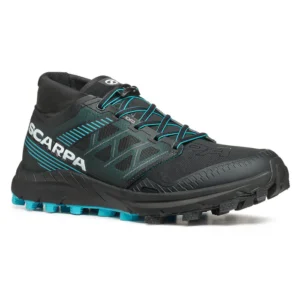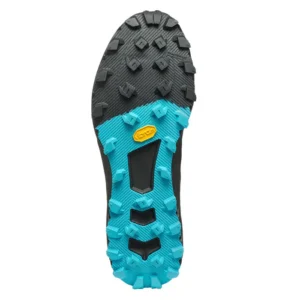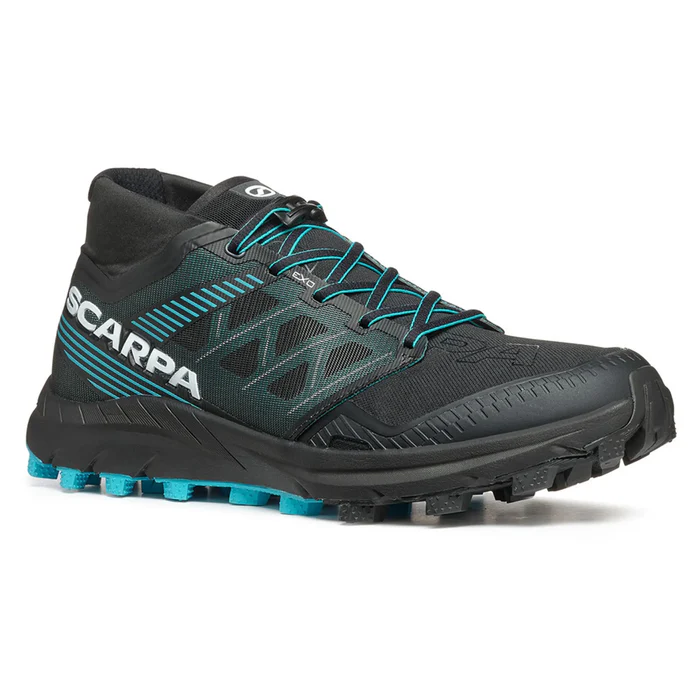I’ve worn Scarpa footwear of various types for forty years – my first serious pair of boots were the then brand new, but now legendary, SL’s. Since then I’ve used their classic mountaineering model, the Manta, the lightweight and technical Charmoz, freeride ski boots such as the Typhoon and for mooching around and approach work, their brilliant and comfortable Mescalito shoes (reviewed elsewhere on this page). Scarpa use many different lasts (foot shapes) throughout their footwear range which can often mean that if one doesn’t suit you then another will. For that reason, careful assessment by an experienced boot fitter will help quickly cut through to the appropriate models.
Over the last few years, Scarpa have been gaining a significant toehold (pardon the pun!) in the trail running sector, resulting in the design of a few models that very much suit the UK market and our unique terrain and conditions. Being located at the Northern end of the Peak District, our upland areas of heather, grasses, peat bog and gritstone are a challenge for any footwear and a great place to test new products to the limit.

My first experience of a Scarpa trail running shoe has been with the Spin ST, a nice looking model that was new for the 2023 Autumn season and a sibling to three other products in the Spin series of trail running footwear.
Understanding where the Spin ST fits in to this range is important as to whether it’s going to be the shoe for you. The other models are orientated towards the medium to long distance sphere of activity on firmer ground and as such are high on cushioning for repeated impact over a long period of time with squarer toe boxes. The ST is marketed as a more precise fitting, performance-based shoe for shorter distance routes or races involving technical and demanding terrain. Accordingly, the toebox is fairly snug – this isn’t a shoe for a high-volume foot! But what really sets it apart from its relations is the aggressive 7mm deep lugged and sticky outsole – a big hint towards the terrain it works brilliantly on!
I can’t in all honesty say that the Spin is a perfect fit for my widish forefeet – I had to jump up a size from normal just to take the pressure from the big toe joint. But that’s footwear for you – just ‘cos a shoe suits your mate, it doesn’t mean you’ll get on with it! But given I wasn’t going to be in them for hours at a time, I figured I could still give the Spin ST’s a few decent test outings.
My initial thoughts were, “is it reinforced enough for Pennine use?” It’s been designed to be light and that often means durability is sacrificed. But if you look carefully, you’ll see the likely areas of pressure and abrasion are well protected and the mesh upper is a tight weave unlikely to damage easily. That said, there’s plenty of opportunity for the shoe to drain of water after a stream crossing or puddle immersion.
This shoe balances well between enough structure to support the foot and the need for feeling the ground through the sole. As such, it’s quite flexible but without feeling too minimal and the designers haven’t gone overboard with cushioning. Yet there’s still enough to take the sting out of the occasional heavy heel landing and ample torsional and longitudinal firmness for off-piste stability.
 For an old boy like me, the need for a shoe to pile downhill fast passed me by many years ago. But everyone will appreciate the awesome traction and grip of this shoe for descending – whether on mud, wet grass, slimy slabs, fresh snow or rock. The compound of the Vibram outsole is stickier than anything I’ve tried previously and as long as you’re not doing big miles on the tarmac to get to the off road stuff, shouldn’t wear too quickly. Our biggest nemesis on the tops around Marsden are the miles of slabs laid on the Pennine Way that when damp can feel like running on ice in most footwear. I’ve used screw in studs on other shoes in the past but the Spin ST’s are surprisingly secure once scrubbed in a bit.
For an old boy like me, the need for a shoe to pile downhill fast passed me by many years ago. But everyone will appreciate the awesome traction and grip of this shoe for descending – whether on mud, wet grass, slimy slabs, fresh snow or rock. The compound of the Vibram outsole is stickier than anything I’ve tried previously and as long as you’re not doing big miles on the tarmac to get to the off road stuff, shouldn’t wear too quickly. Our biggest nemesis on the tops around Marsden are the miles of slabs laid on the Pennine Way that when damp can feel like running on ice in most footwear. I’ve used screw in studs on other shoes in the past but the Spin ST’s are surprisingly secure once scrubbed in a bit.
Laces are traditional crossed affairs but the eyelets they run through pull on webbing woven into the upper to snug the shoe up around the mid foot and heel. There’s also a simple but cunning lace lock device that removes the need for tying a bow and a little pocket to stash the lace ends into.
Visually, the shoe looks a little boot like because of the soft Lycra cuff enveloping the lower part of the ankle bones. This provides some welcome protection from knocks and abrasions and will help keep debris out for most although with my stick thin ankles there was a tiny gap. You don’t feel the ankle cuff in any negative way – the shoe still feels super light and nimble.
The heel to forefoot drop is 4mm – just enough to take some stress off the Achilles tendon whilst still feeling in touch with the ground. I think those in the minimal or nil drop camp could still be happy with the reasonably natural sensation that comes through the shoe from the terrain, whilst anyone needing a degree of cushioning is still well catered for. There’s a basic foam insole fitted as standard which I replaced with a pair of Sidas 3Feet Run Protect insole as in all my running shoes.
So, to sum up; if I was twenty years younger and running shortish yet technical mountain and fell routes at speed then these would be a great go to shoe just for their immense grip alone. They hold the foot incredibly well when laced precisely and are light enough for the gram counters to race in at a serious level.
Folk wanting more impact protection on firmer surfaces over longer distances, will find the Spin Ultra and Infinity models well worthy of consideration. They feature much more cushioning and in the case of the Ultra, a 6mm heel to forefoot drop to reduce impact stresses still further.
For those like me who are looking for that elusive mid to long distance winter shoe that can protect, grip, insulate and cushion, then Scarpa’s Ribelle Run Kalibra ST and G models are winning favour in events such as the Winter Spine Series races. I’m currently on crutches after a mishap a couple of weeks ago but once recovered, there’s a shiny new pair of Kalibra ST’s waiting to be given the full Pennine test treatment.
